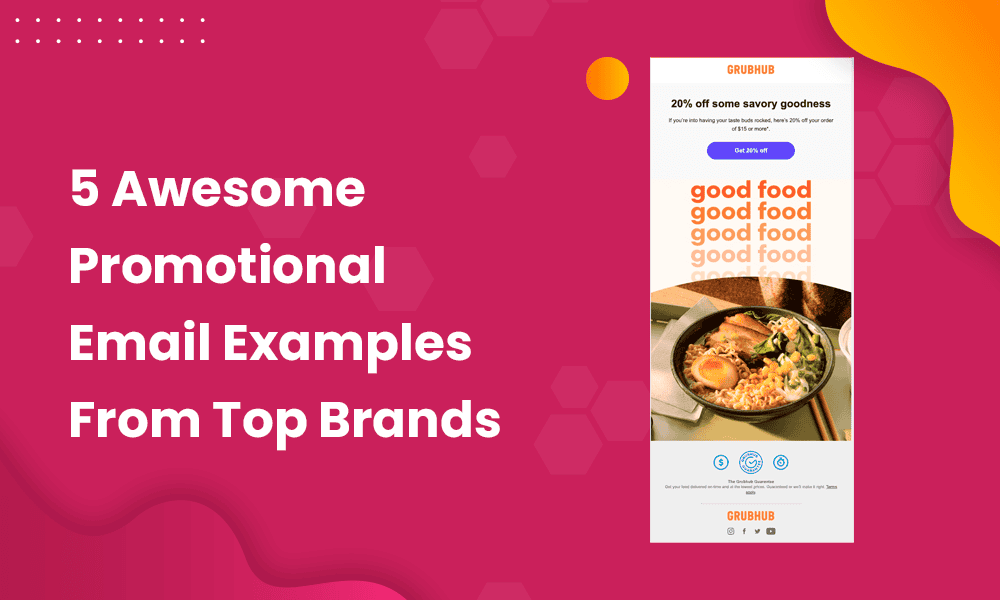Promotional emails are a powerful weapon in your digital marketing arsenal. You know that.
Every marketer knows about the high ROI for email marketing (a whopping 4,400%) and the relatively low time investment. According to Litmus, 87% of brands claim that email marketing was crucial to their digital marketing success, and for good reason.
But you’ll compete with hundreds of emails and competitor brands in each client’s inbox. Every marketer is already trying to craft compelling promotional emails!
Then, the real question for a marketer becomes — how do we stand out from the rest and grab customer attention?

All successful promotional emails bank on these basic elements for sure:
- A compelling, relevant subject line (use personalization and segmentation techniques)
- Focus on adding value to the customer rather than being pushy
- Content optimization for reading across devices
- An enticing call-to-action (CTA) at the end
Now, could it be this simple? There’s more to drafting irresistible promotional emails.
This article will take you through the goals, crucial elements, and best practices for writing excellent promotional emails. You’ll find examples of promotional emails as well.
Ready? Let’s dive right in!
Table of Contents
Key Takeaways
- First, for a successful promotional email campaign, get clear on your objectives and how they align with your overall marketing strategies. These goals could be brand awareness, product promotions, building customer loyalty, or driving website traffic and increasing sales.
- Each crucial element of your promotional email needs to be on point for high conversions. Some of these elements are an effective and catchy subject line, personalized greetings, compelling content, visuals or videos, a direct and clear CTA button, examples of social proof, mobile responsiveness, and testing of formats.
- Some creative and engaging promotional email examples showed how A/B testing, customer segmentation, visuals, multi-email sequences, timing, engaging subject lines, and exclusive offers can make a huge difference to your campaigns.
- Best content writing practices like user benefit-oriented language, conciseness, clarity, and providing value can boost engagement, open rates, and drive sales.
- Using storytelling strategies and emotional triggers to enhance your promotional email content further can also drive sales in the long run. It also adds to brand loyalty and trustworthiness when done right.
- Segmenting your email list is a key factor in the effectiveness of your email campaign. Using creative segmentation strategies, in addition to tried-and-tested ones, can help create personalized campaigns that boost open rates.
Getting the Purpose of Promotional Emails Right
Let’s start with the basics first.
Promotional emails are one of the best and most cost-effective ways to craft a compelling narrative about your brand and foster customer relationships when done right.
This could be any email marketing campaign to inform your customers about new product or event launches, deals, offers, or invitations to sign up. Here’s a compelling example.
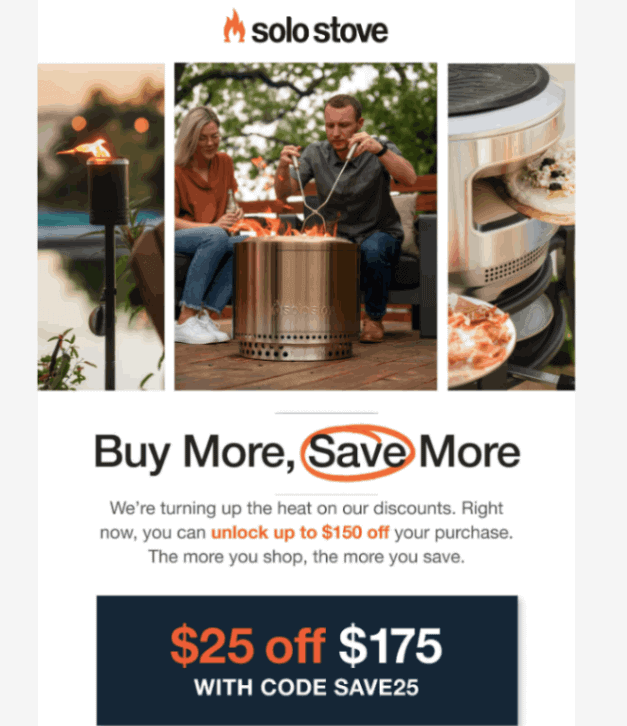
But, when promotional emails go wrong, it can spell disaster for your brand. If your emails become spammy or lack a clear narrative, they could ruin your brand image for customers.
To avoid this, get clear on your promotional email marketing goals from the start. You must also be clearer about how the goals align with your digital marketing strategy.
So, we’ve curated a handy list of promotional email marketing objectives you can customize based on your marketing strategy.
Brand awareness
Every promotional email you send adds another strand to your brand awareness and brand narrative among prospects. The key to building brand narratives is consistency with your messaging and visuals.
Think about the tone of your emails — should you be serious and scientific, or should you take a more emotional approach? Do the tone and graphics in your emails match those on your landing pages and website? With the right consistency and tone, you can solidify your brand recognition and awareness for your small business.
Product promotion
If you want your brand and your products to remain at the top of customers’ minds, then promotional emails are your best bet. And, what’s more, you’ll be able to educate your customers on new product launches, your brand values, and your mission.
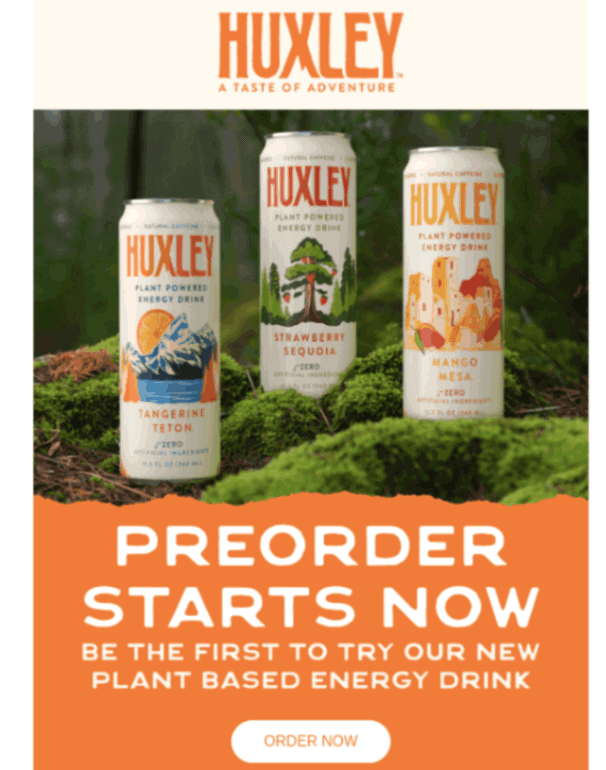
A 2023 study found that email marketing affected the purchasing decisions of six out of 10 customers surveyed! Remember that most prospects and customers prefer to be contacted by email rather than any other form of communication.
You can also cross-sell and upsell complementary products and help customers make informed choices about your products and offerings.
Customer loyalty
Who doesn’t love getting exclusive offers in their inbox from their favorite, trusted brands? That’s right, promotional emails are a great way of enhancing customer loyalty.
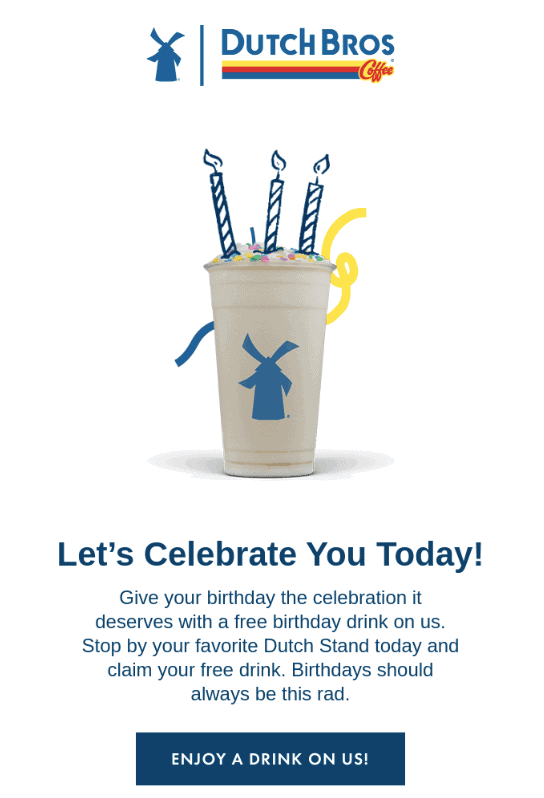
By consistently checking in with your long-time customers and by offering them exclusive perks, benefits, and offers, you can reward long-time customers for their loyalty. It’s also a great way to make your customers feel appreciated, valued, and understood, like the example from Dutch Bros above.
With consistent brand messaging and product promotion, you’ll build enhanced emotional connections with loyal customers and retain their interest over long periods.
Driving website traffic and generating new leads
Promotional emails are a great way to drive more traffic to your websites. With the right, compelling call-to-action (CTA) buttons that prompt readers to browse your eCommerce website, browse through your blogs, or even just visit your company website, you’ll be able to boost your online visibility.
Promotional emails can also be a good way to generate new leads by offering downloadable content like whitepapers, ebooks, or webinars in exchange for contact information from prospects.
Read more: Click-to-Cart: The Art of Crafting Irresistible Promotional Emails
Elements of a High-Converting Promotional Email
Once you’re clear on your goals for drafting promotional emails, the next step is to get your team together and start crafting compelling emails!
So, we’ve gathered all the crucial elements of a high-converting promotional email. You need to nail each of these and be in good standing to make the most of your email campaigns.
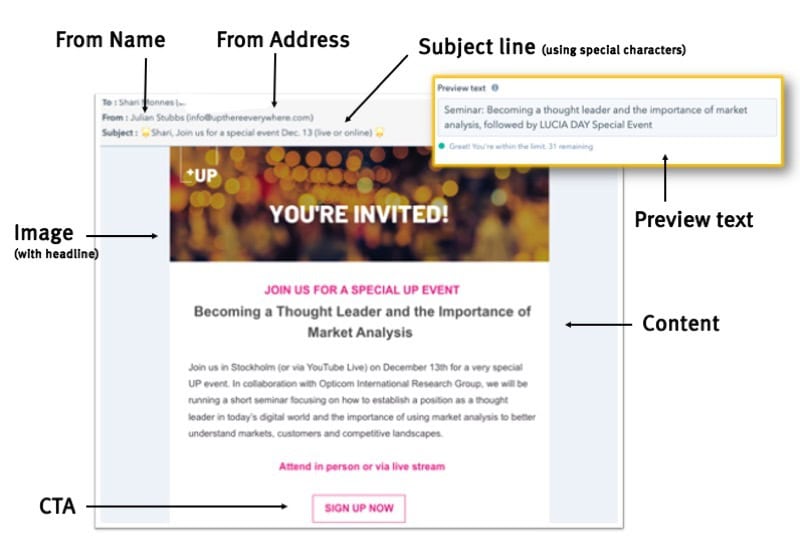
1. A compelling subject line
Your subject line is the first thing people will see. So, it’s the first element on our list. According to a recent survey, 69% of email recipients report emails as spam based on the subject line alone! Remember that your subject line can make or break your promotional email campaign.
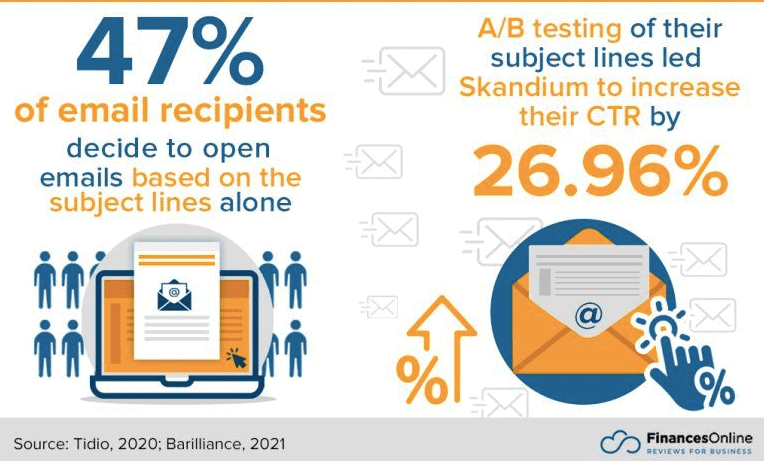
And your subject line prompts people to open your emails in the first place. A great option is to personalize your email subject line to your customers. One way of doing this is by including the recipient’s name. After all, this has been shown to boost your open rate by up to 39%!
There are many ways you can create an unmissable subject line. You can choose any of the strategies:
- A funny subject line
- A straightforward subject line
- A suspenseful subject line
- A subject line with keywords like “introducing”, “celebrate” etc.
Here are some great, real-life examples of compelling subject lines:
-
- Cosy Club: Bam! You’ve unlocked 10% off your order!
- Google: Don’t forget to redeem your Local Guides Reward!
- Backcountry: Bet you can’t translate this climber lingo! 🧐
- Dunkin’ Donuts: This reward requires both hands! 🙌
- Zoom: Psst! You’re invited to shop our Black Sale early
2. Personalized greetings
When it comes to subject lines, never underestimate the effects of a personalized subject line. After all, it is human nature to respond to something curated, keeping your interests in mind. According to recent surveys, personalized subject lines and personalized greetings doubled the open rates for promotional emails.
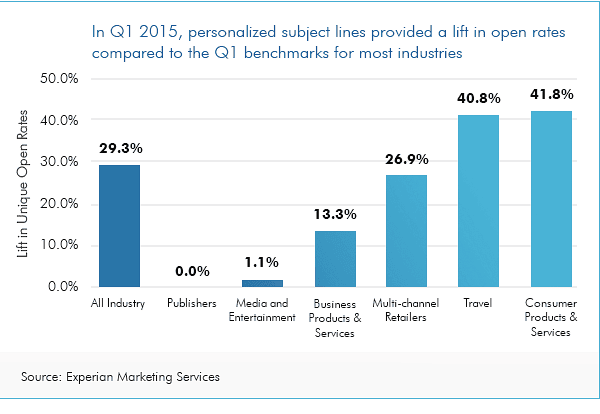
So, what kind of personalization works best for subject lines? We’ve got you covered!
- Personalized subject lines with the customer’s name were found to be the most effective
- Subject lines with their company name are also quite effective
- Personalize the subject line using a key customer pain point. This, too, improves open rates.
And we’ve curated some of the best-personalized greeting examples to inspire you to create your version! Here they are:
- “Hi [Name], we’ve got a special deal just for you!”
- [Name], we think you’ll love this offer!
- [Name], only two days left to grab 60% off on [product name]
- [Name], you’re on the nice list! Grab your Christmas offer today …
Read also: Funny Email Subject Lines to Copy and Use (And Examples From Big Brands)
3. Compelling content and visuals
A winning promotional email creates a balance between content and visuals.
And this isn’t just our take! A recent survey by Forbes found that customers retain 55% more information when compelling visuals are used! Additionally, using visuals and images has improved click-through rates, boosted shareability, and improved emotional engagement with emails!
But you’ll need to ensure the visuals are relevant and tie in with your brand colors and overall marketing goals. Plus, visuals are a great way to break up larger chunks of text — making your email more readable. Here’s a great example.
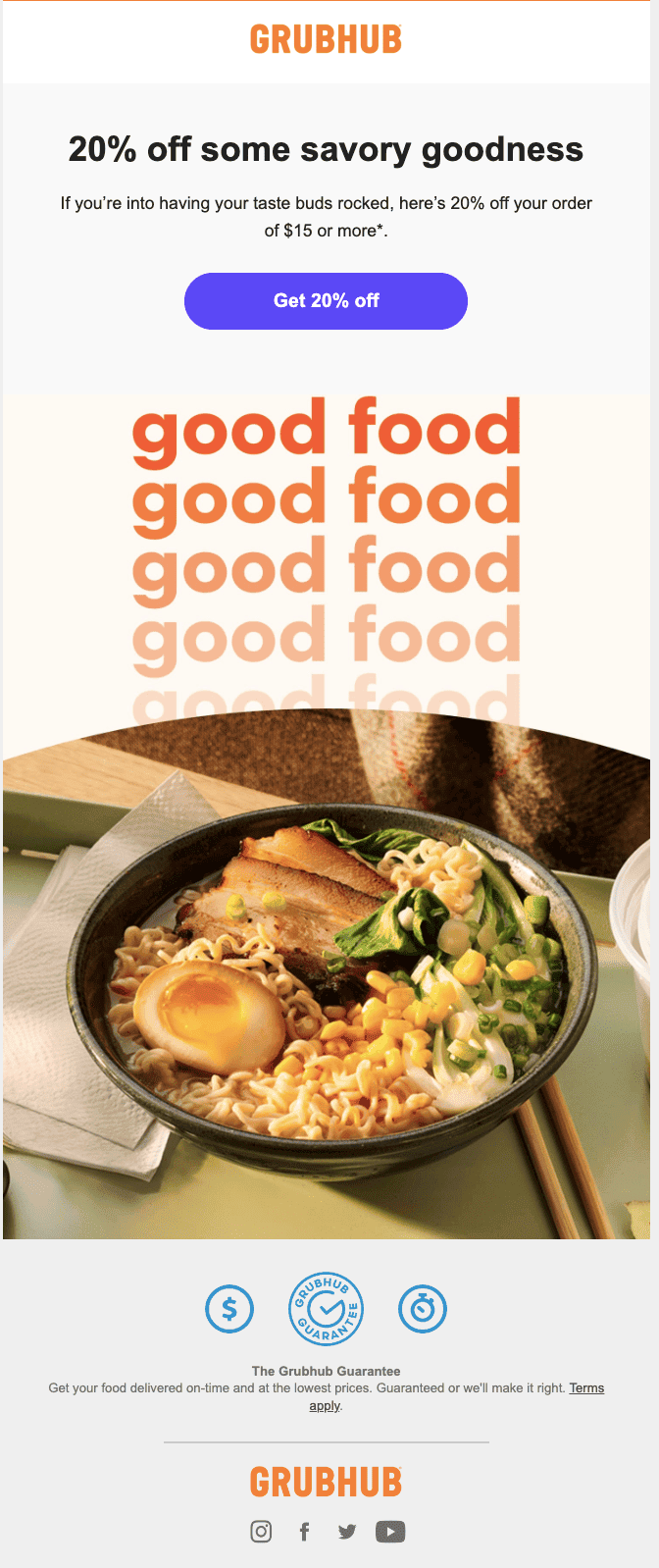
Here, the content isn’t overloaded, but the lines pack a punch and convey a sense of urgency. The line “good food” ties in with the brand colors and leads the reader to the visual of delectable and wholesome food. It creates a sense of warmth and well-being, encouraging customers to take action and use the offer discount.
And it does all this without overwhelming the reader in any way. To get similar results, use these best practices:
- Use professional software and plugins. Stay updated with the latest trends in design.
- Maintain visual consistency with fonts, colors, and content.
- Optimize visuals for size and resolution for faster load times.
- A/B test visuals across devices and customer segments.
- Constantly monitor key metrics to test the efficacy of visuals and regularly update content with the latest trends.
Read also: 7 Funny Email Examples & Tips to Craft Your Own Comic Gold
4. A clear and actionable CTA
Your email campaign would remain ineffective without a convincing and clear call-to-action (CTA) button, even with compelling content and visuals. And no, we are not exaggerating! Surveys have shown how adding just one CTA button to your email boosts sales by up to 1,617%! Well, that’s a huge number.
So, how can businesses across industries and sizes leverage CTAs to boost engagement and sales rates? We’re here to show you how.
First, ensure that your CTA content highlights benefit-oriented language. What do we mean? Rather than writing generic content like “Click here,” your goal is to highlight a clear and actionable way the reader can benefit from clicking on your CTA button. Consider text options like “Claim Deal Now,” “Shop Now,” and “Get Started Now.” These are likely to make an impact.
Here’s an example from Adobe:
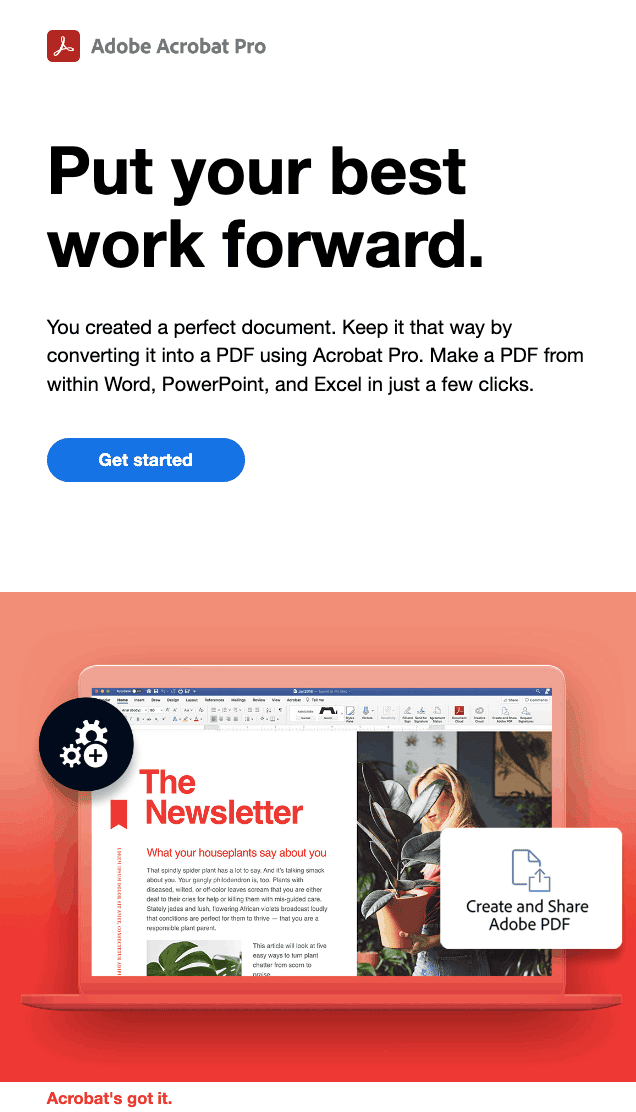
Here, using actionable text with contrasting colors helps the primary CTA button stand out. The CTA is surrounded by whitespace, which gives it a clean, decluttered look. Design elements like rounded edges, shadows, and gradients usually make it even more appealing.
If you’re promoting a new discount, consider creating a sense of urgency in your CTA by using text like “Grab your Deal now” or “Exclusive Deal.”
Finally, don’t forget to personalize your CTA based on customer’s past interactions and preferences. Also, A/B testing and optimization for different devices can help boost the efficacy of your CTA buttons.
Read also: Promotional Email Templates to Drive Sales and Engagement
5. Some social proof (testimonials, ratings)
Social proof is the way to go if you want to build trust and enhance your credibility with your customers. Now, this could be a small part of a promotional email. Or, you could send a dedicated email highlighting social proof as part of a larger campaign.
If you already use social proof, there are always options to diversify it. How? Well, consider stepping out of the tried and tested reviews and testimonials. You could also include case studies, social media mentions, influencer endorsements, trust badges, customer count, and statistics.
Here’s a classic example of a testimonial email done right:
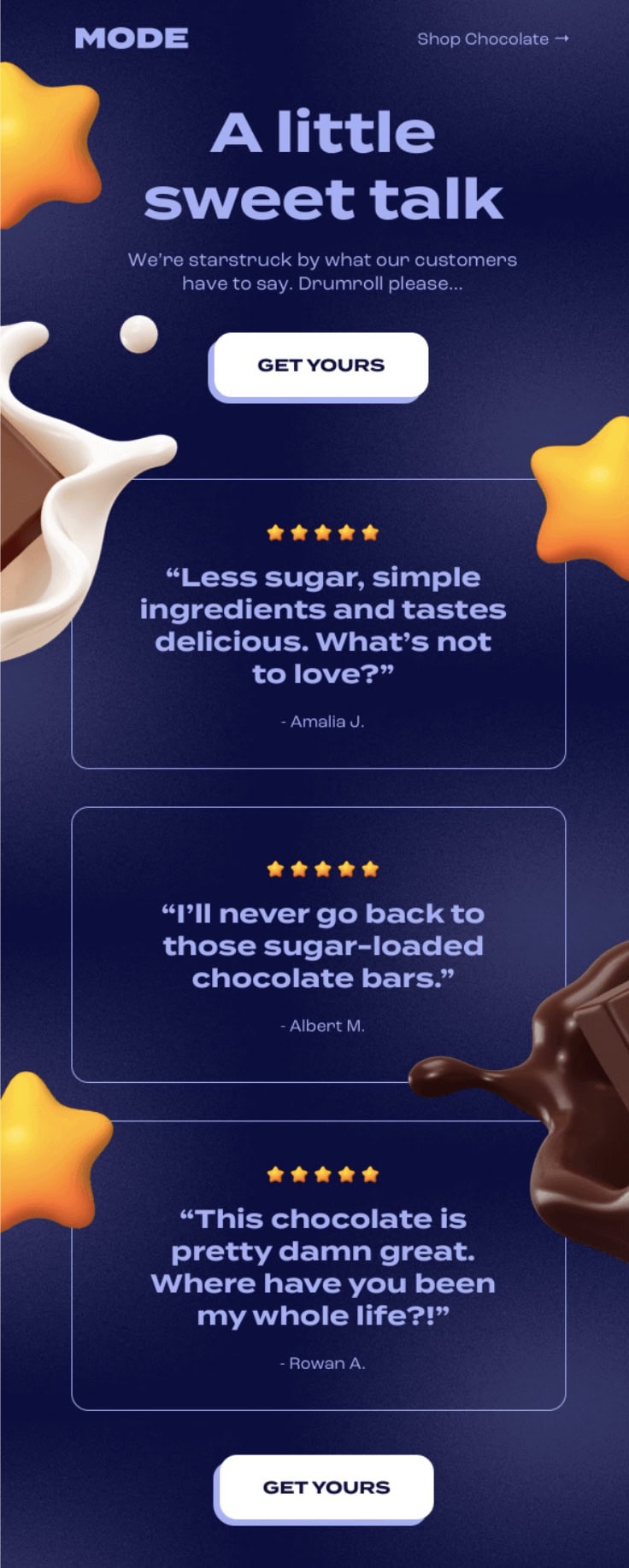
Never go overboard with the number of testimonials. Keep it short and sweet, as this company does, and you won’t go wrong. Here’s how you can improve your use of social proof in promotional emails:
- Ensure you only use relevant social proof and never go overboard with the number. Ideally, 3-5 reviews are more than enough across industries.
- Use only authentic reviews, case studies, and badges. If not, it will diminish your brand credibility and reliability in the long run. Also, ensure your social proof complies with the Federal Trade Commission (FTC) and other state guidelines. Disclose any connections between your brand and individuals endorsing your products, if any.
- Highlight reviews from credible, trustworthy individuals like long-term customers, industry experts, and trusted organizations.
- Finally, don’t forget to optimize and personalize your social proof for different customer segments based on past interactions.
Read also: A Quick Guide on Insurance Email Marketing
6. Mobile responsiveness and testing various formats
Remember the last time you were forced to zoom into an email from your mobile or tablet and how annoying it was? This is a sure-shot way to get prospects to click the unsubscribe button!
But luckily for us, a mobile-responsive email can help. Mobile responsiveness for promotional emails means that the email is specially coded to automatically adapt its display for viewing across devices. And yes, this includes mobiles, laptops, and tablets.
Typically, a mobile responsive email contains two layers of CSS code. In the second layer, the code automatically handles how the email is displayed on mobile devices or tablets. With over 50% of US consumers checking marketing emails on their mobiles, mobile responsiveness is a feature you can ignore at your peril!
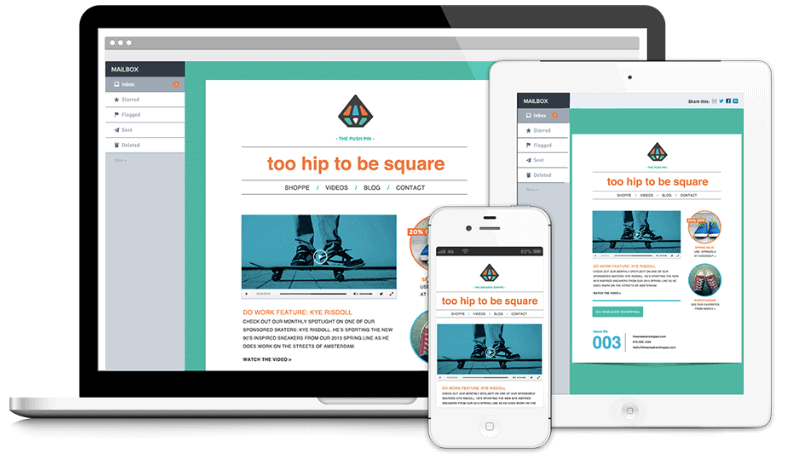
Keep these factors in mind while designing your mobile-responsive promotional emails:
- Use only mobile-responsive email templates. Run A/B tests across several versions across devices before sending.
- Make sure your CTA button is clickable on mobile devices. Use HTML code to create bulletproof buttons, as image-based CTA buttons may not open across devices.
- Optimize your font and images for easy viewing without wi-fi connectivity. Add Alt-text to all images.
- Avoid Flash and hover effects, and stick to HTML and CSS code for all interactive elements to ensure a smooth customer experience.
- Include a plain-text version option of your email for devices and email clients that may not support HTML versions.
Now that you’ve got the basics right let’s look through some examples of stunning promotional emails to inspire you.
Read more: Promotional Email — How to Write Emails that Convert
5 Awesome Promotional Email Examples From Top Brands
Ready to get your creative juices running? We’ve curated five compelling promotional email examples to help you get inspired. We’ll give you a breakdown of what makes each email so effective. Feel free to use these tips to improve your promotional emails.
1. Retail sales promotion
Sales promotions are an effective way of reaching out to new and old customers to boost sales. Here are the top benefits of a retail sales promotion email. When done right, you’ll reap many benefits without blowing up your marketing budget.
Here’s a stunning example of a retail sales promotion email. Let’s understand what makes it effective and what you can take away to apply to your own retail sales email campaigns.

This email strikes all the right chords. First, it focuses on the product’s benefits and the discount to the reader.
The tagline “Expires Tomorrow” creates a sense of urgency and motivates customers to take immediate action to claim the offer. Also, note that the discount is the primary focus of the email. It highlights what exactly the customer will get without leading them on. The email includes all relevant details like the discount percentage, shipping charges, and any exclusions and limitations.
But, it doesn’t stop with just the offer either. Adding a clickable, informative video at the end is smart, especially if you’re reaching out to new customers who may want more information about the product before clicking the CTA button.
Finally, the trust badges at the bottom add a sense of reliability and credibility to the product.
2. New product launch
So, you’ve planned and launched a new product after months of planning! This demands an email campaign worthy of all the time and effort you’ve already invested in it, right? Your new launch product email campaign, too, requires rigorous planning and seamless execution.
First, ensure that your campaign is aligned with your overall marketing strategy for the new product. Then, you need to set clear objectives for your product launch email campaign. Are you looking to generate awareness simply? Or do you want to drive pre-orders and sales?
Once your campaign aligns with your marketing goals, you can begin to draft your email to highlight your unique selling propositions. Here’s a great example.
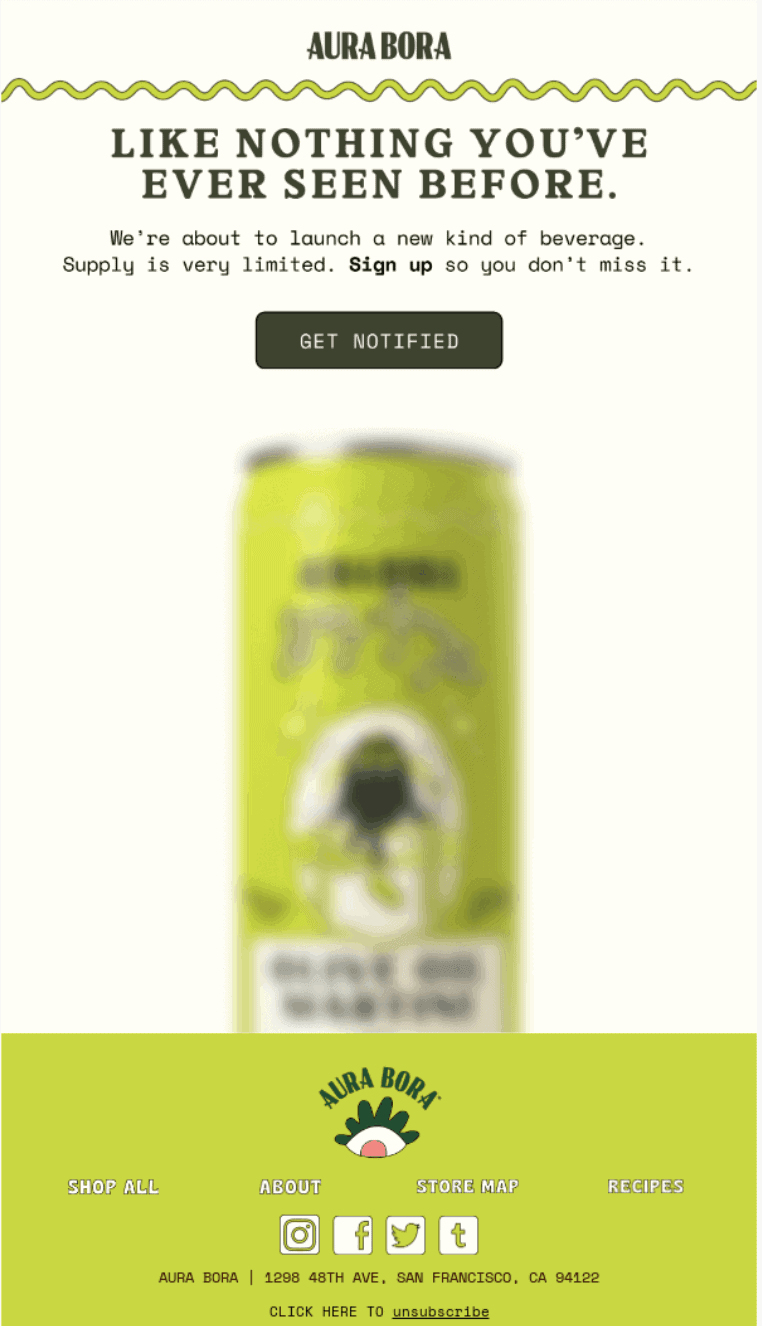
This campaign by Aura Bora skillfully uses a multi-email sequence to build anticipation and make customers curious about the new product. The primary CTA allows customers to sign up for notifications when the product is launched. It also creates a sense of urgency with the limited edition and the blurred visual.

Then, the follow-up email finally launches the product. They effectively highlight their USP and draw the customer in with their compelling visuals and descriptions. The CTA button “Start Sipping” also offers a clear action to order the product!
3. Event invitation
Events, workshops, and webinars are a great way to meaningfully engage with potential and old customers alike.
Event invitation emails are an important part of promotional email campaigns as they strive to increase the number of attendees for these events.
Ideally, your event invitation email has to build anticipation and generate genuine interest and buzz around the event. So, don’t miss out on any crucial details like the date, time, venue, speakers, and any other special instructions or requirements from attendees. Here’s a stunning example from AirBnB for a virtual gathering.

The invite highlights various events the customers could participate in from the comfort of their homes. Whether it’s cooking classes or concerts, customers can explore all their options before signing up.
Remember, personalization and segmentation are your best friends here. You can curate your event email invites based on past interactions and customer interests for the best results.
Finally, the email ends with an option for customers to buy gift cards for their friends and family, boosting engagement. Also, consider sharing your event invite on social media channels to boost engagement.
4. Exclusive offer for subscribers
What better way to make your long-term customers and subscribers feel special and valued than by offering exclusive offers and discounts?
Typically, buyers at this stage of the buyer’s journey won’t need a ton of new information to make their purchase. The goal is to incentivize these buyers to drive purchases and increase brand loyalty. You also end up increasing the overall customer lifetime value over time.
By offering the perfect exclusive offers, you not only build an emotional connection with long-time customers, but you can also set yourself apart from your competitors. Here’s a great example from Dr. Pepper’s campaign.

This email combines compelling visuals and remains consistent with their branding. The tagline “Dive into the summer you deserve” creates a sense of value for the loyal customer. Labeling their exclusive offer “Pepper Perks” creates a sense of exclusivity and builds up a sense of anticipation.
The major perks are laid out in a fun and easygoing layout with just the right amount of content without overpromising or going over the top. You can personalize the campaign for customer preferences for optimum results. Remember to optimize your email for viewing across devices and A/B test your emails before sending them out.
5. Seasonal campaign
Seasonal email campaigns are crucial to your overall promotional email marketing strategy. Whether it’s Labor Day, Christmas, or Thanksgiving, it’s a time when your prospects are willing to bust out their wallets and splurge on themselves and their loved ones. Here’s a handy guide on the seasonal spending trends (2019-23) published by the NRF.
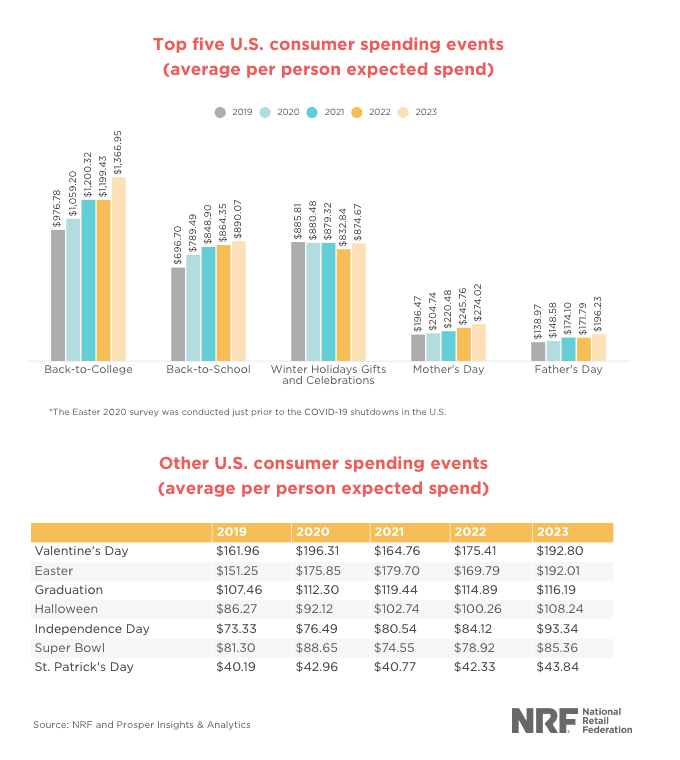
With a well-timed seasonal email promotional campaign, you can stay on top of trends and drive customer retention and long-term loyalty. Here’s an effective example from RXBAR.
The email evokes a spooky Halloween spirit while tying the theme perfectly with their overall branding. The line “All Treats, No Tricks” is an effective one-liner that perfectly encapsulates their Halloween discount. Customers can also choose a “seasonal variety pack” if they cannot pick just one flavor.

At the end, the email encourages buyers to use a code to redeem the discount along with free shipping. The email sells the limited-time discount and encourages readers to click on the CTA button that says “Shop Now.”
The email is interspersed with shareable seasonal tidbits like a workout using pumpkins and instructions on how users can create RXBAR-themed Halloween costumes. What a creative way to boost shareability and engagement!
Remember to plan well ahead for your campaign, and don’t shy away from segmentation and personalization to get the best results from your seasonal email campaigns.
Now that you’ve got your creative juices running, let’s look at how you can craft your captivating promotional email campaigns.
Crafting Your Promotional Email: Best Practices & Tips
Once you’re clear on your promotional email objectives, frequency, and how they tie in with your overall marketing goals and budget, this section will help you with best practices, content, and segmentation. Let’s dive right in.
- Focus on the benefits, not just the features: Clearly understanding your target audience’s pain points will help you create great content. The goal is to focus on the benefits on offer rather than just listing the features of your products (however great they may be!).
- Provide value, don’t just sell: As a marketer, your goal is to drive more sales by providing valuable content. Avoid any hard selling. Curate content like customer success stories, behind-the-scenes content, and interesting anecdotes in addition to providing helpful information.
- Keep it simple and concise: Remember that everyone’s busy and attention spans are dropping by the year. So, keep your email content simple and concise. Never overload your emails with text. Also, ensure that you break up larger chunks of text with the right visuals.
- Always test and iterate: Get as creative as you like, but never forget to test various types, formats, and messaging strategies with various segments of your target audience. Be it subject lines, CTA buttons, or visuals, use the test results and feedback to create an iterative process for improvement.
Use storytelling and emotional triggers to boost engagement
Storytelling is a universal human instinct that has existed since the inception of our species. Whether it was through cave paintings or the latest blockbuster — humans are wired to respond to narratives and stories.
Emotional triggers are also a key component of storytelling. This means having the ability to evoke emotional responses — however mild or intense — in the minds of others. So, how can you evoke these ancient human instincts in your promotional email marketing campaign?
Using storytelling and emotional triggers, you can easily make your promotional emails more relatable, engaging, memorable, and compelling to your readers. Always use words, tones, and phrases that show personality and evoke a connection with the readers.
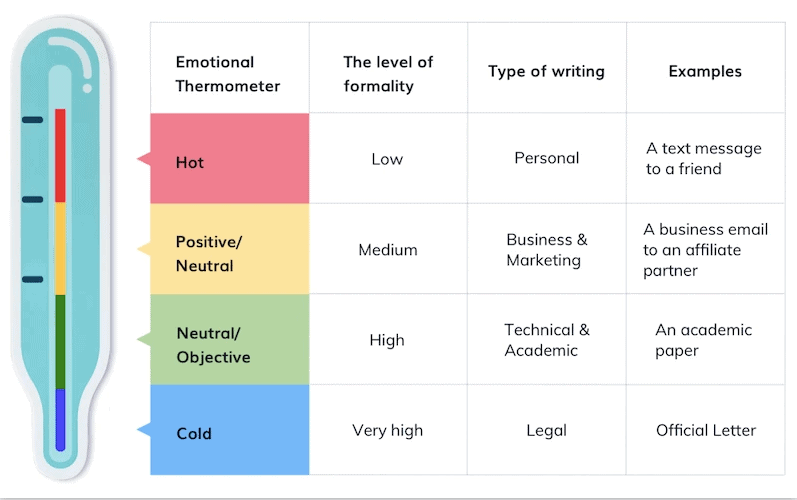
At the beginning of your email, you can use questions, intriguing statements, or anecdotes to evoke a sense of curiosity and intrigue.
The middle segment usually hinges on a conflict or a key pain point for your target audience. This would create a sense of urgency, empathy, and heightened awareness of their problems.
Finally, show (don’t tell) your readers how your products could help alleviate this problem. So, never touch upon a problem your company can’t solve for the reader.
Here’s a short list of commonly used emotional triggers for promotional emails:
- Anticipation, curiosity, excitement
- Belonging, connection, feeling part of a whole, feeling valued, vanity
- Fear of Missing Out (FOMO)
- Hope, motivation, confidence
- Urgency, scarcity
Personalize your emails
If you do not personalize, you do not aim for engagement. It’s as simple as that.
Users only want to interact with the promotional emails meant for them, not just another promo haul broadcast.
This way, you preserve your audience’s sense of importance and espouse their trust.
For an enhanced personalization of your email, you can use the recipient’s names, segment your email list based on interests or past purchases, and tailor your content to serve each segment.
Focus on value
Your focus should be on your value propositions to effectively convey your product or service’s benefits.
Make sure you put your product’s features in bullet points so they are easy to understand in a few words.
If your value proposition is a sale’s discount or an event’s benefits, make sure it is compelling enough to prompt the user to take action.
Optimize for mobile
Make sure to optimize your subject line for mobile view. Most people check their emails on their phones.
Nearly 1.7 billion people read their emails on mobile phones, much outnumbering PC users, who number roughly 0.9 billion.
By ensuring that your subject line falls within the range of perceived optimum length, you are also helping yourself appeal to most of the email opening audience.
Strategies to segment email lists for more personalized campaigns
We’ve talked about segmentation and its benefits quite a bit already. And we all know there are almost infinite variables and criteria on which you can segment your email list. You could segment based on demographics, geography, or psychographics. And you’re probably probably using behavioral segmentation like abandoned carts and website activity.
Here are two behavioral segmentation strategies that can help you send even more personalized emails that would make a larger impact.
- Encourage customers when there are changes in behavior: If a customer was making regular purchases and tapered off a couple of months ago, it’s your chance to step in with a promotional email. Try sending this segment larger discounts or exclusive offers. A survey could also help you collect more data points to revise your strategies.
- Influence customers with the highest email open rates: Customers with the highest email open rates do so because they resonate with your brand and enjoy your products. You can lean into this segment to drive further sales. Consider offering them exclusive perks, discounts, and behind-the-scenes content to maintain engagement.
Conclusion
We cannot understate the power of excellent promotional email marketing campaigns in the digital marketing mix. They’re a sure-shot way to meet several marketing goals without draining the marketing budget.
If you’re a small business struggling to create compelling promotional emails, keep these baselines in mind -keep it simple; keep it creative. People respond to narratives and good ideas, so you don’t have to complicate it. One single idea conveyed creatively and clearly will likely go a long way.
With these guidelines, your business will boost customer engagement and drive sales through promotional email marketing. What are you waiting for? Get started today.
EngageBay is an all-in-one marketing, sales, and customer support software for small businesses, startups, and solopreneurs. You get email marketing, marketing automation, landing page and email templates, segmentation and personalization, sales pipelines, live chat, and more.
Sign up for free with EngageBay or book a demo with our experts.
FAQ
1. How often should I send promotional emails to my subscribers?
Each company needs to find the right cadence for sending out promotional emails. According to recent research, an average of two to three emails per month works the best for B2B and B2C companies.
However, there are caveats here, as your ideal email frequency and cadence will depend on factors like your industry, product lifecycle, subscriber preferences, and special events. Here are these tips to make the best of your email campaigns and find the right cadence:
- Allow customers to choose their cadence by setting up a preference center
- Segment your email list based on customer preferences
- Give subscribers the choice of opting down whenever they click the unsubscribe button
- Send out your emails only in a logical sequence. For example, send a welcome email, followed by a discount coupon.
- Regularly test your subject lines and measure the outcome of your campaigns using a decent analytics tool.
2. What is the best time and day to send promotional emails?
Statistics vary slightly by industry, but on average, Tuesdays and Wednesdays are the best days to send promotional emails for both B2B and B2C companies. Sundays are the worst days to send promotional emails. Usually, the best time to email is between 9 AM and 12 PM and 12 PM and 3 PM on weekdays.
Gather data and A/B test several time slots and days to optimize your promotional email send times. Also, keep an eye on the open and click-through rates.
3. How do I measure the success of my promotional email campaigns?
You need to measure the following KPIs regularly and constantly tweak your email campaigns for the best results. The key KPIs you need to track are:
- Open rate
- Click-through rate
- Click-to-open rate
- Unsubscribe rate
- Bounce rate
- Conversion rate
- Email forwarding rate
- Spam complaint rate
- Campaign ROI
- Engagement by device
4. Can I send the same promotional email to all my subscribers?
No, never blindly send the same promotional email to all your subscribers. Rather, create a segmented email list based on demographics, geography, customer preferences, and behavioral segmentation. You also need to remember the customer stage in the buyer’s journey. Loyal customers would have different needs compared to new subscribers.
Segment your email list based on several criteria and send well-timed, relevant messages to each segment. Finally, remember to A/B test your emails and segmentation to improve your promotional email campaigns continually.
5. How do I avoid my promotional email being marked as spam?
Even the best marketers get some of their emails marked as spam. But, if it happens regularly, you’ve got a real problem. So, here are some tips to keep your promotional emails from being marked as spam regularly:
- Use only a consistent and recognizable name and email address.
- Authenticate your email using Sender Policy Framework (SPF), DomainKeys Identified Mail (DKIM), Domain-Based Authentication Reporting & Conformance (DMARC), or Brand Indicators for Message Identification (BIMI). Any of these authentication frameworks will improve your deliverability and ensure emails go straight to the inbox instead of the spam folder.
- Use a double opt-in system to ensure genuine interest in receiving your emails.
- Regularly monitor your sender’s reputation.
- Implement a sunset policy to remove unengaged subscribers.
- Provide easy options to unsubscribe from your emails.
- Avoid purchasing email lists at all costs, as it can damage your sender’s reputation in the long run.
- Ensure compliance with national and state internet privacy laws like CAN-SPAM, GDPR, etc.
- Send only relevant content at the right frequency.
6. What should I do if my promotional email has a low open rate?
If your promotional email open rates have suddenly dropped, here are some immediate actions you can take.
- Improve and A/B test your subject lines. Make them more intriguing and catchy, and try to use emojis. Consider shortening your subject lines to 30-50 characters at all times.
- Clean your email list and remove inactive subscribers. Build your email list organically, and clean it out every 4-6 months.
- Identify whether you can attempt to re-engage some inactive subscribers based on past behavior.
- Use double-opt-in for your mailing list if you haven’t already done that. Ask subscribers to whitelist your emails and add you to their address book.
- Optimize your email sending frequency and send times immediately.
- Never send any irrelevant content. Return to your content drawing board and ensure your content meets customers’ needs and adds value.
- Avoid spam filters. Never bait-and-switch subscribers with deceptive subject lines.
- Make your content more engaging by using emotional triggers and storytelling. Use humor wherever possible.
- Ensure all your promotional emails are optimized for viewing on mobiles and tablets.
- Run more emails through the email spam checker regularly.
- Personalize your email content to ensure it reaches the right subscribers and addresses their pain points.
